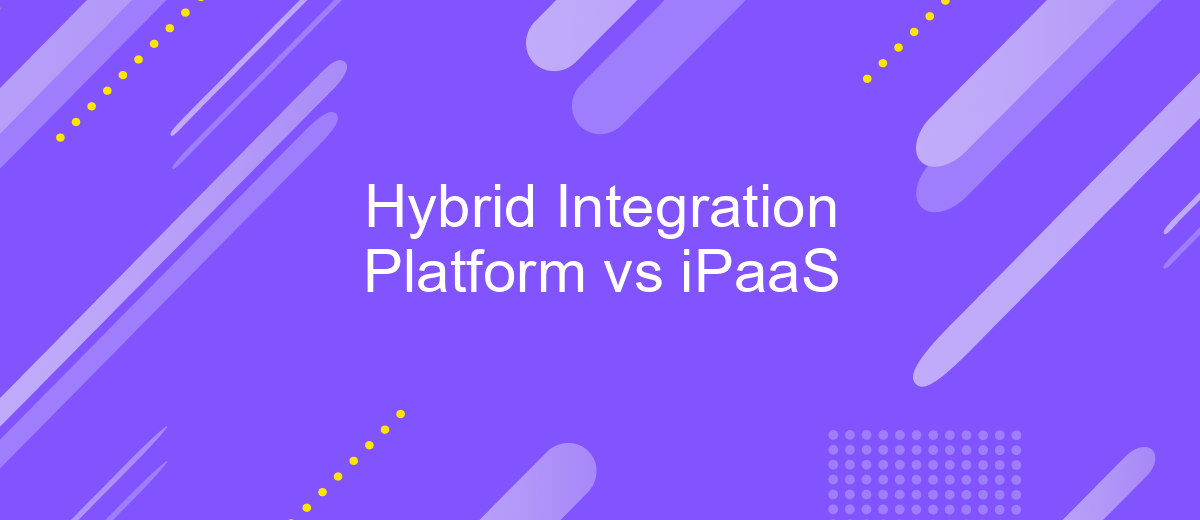Hybrid Integration Platform vs iPaaS
In today's rapidly evolving digital landscape, businesses face the challenge of integrating diverse applications and data sources efficiently. Two prominent solutions have emerged to address this need: Hybrid Integration Platforms (HIP) and Integration Platform as a Service (iPaaS). This article explores the key differences, advantages, and use cases of HIP and iPaaS, helping organizations make informed decisions for their integration strategies.
Introduction
In today's rapidly evolving digital landscape, businesses are increasingly reliant on seamless data integration and automation to stay competitive. Two popular solutions that facilitate these needs are Hybrid Integration Platforms (HIP) and Integration Platform as a Service (iPaaS). While both offer unique benefits, understanding their differences is crucial for making an informed decision.
- Hybrid Integration Platform (HIP): Combines on-premises and cloud-based integration, offering flexibility and control.
- Integration Platform as a Service (iPaaS): A cloud-based solution that simplifies integration processes, making it ideal for businesses looking for scalability and ease of use.
Choosing between HIP and iPaaS depends on various factors such as your existing infrastructure, integration complexity, and business goals. Tools like ApiX-Drive can further streamline the integration process by providing user-friendly, automated solutions that bridge the gap between different applications and services. Understanding these options will help you optimize your integration strategy and drive business growth.
Hybrid Integration Platform (HIP) vs. Integration Platform as a Service (iPaaS)

Hybrid Integration Platform (HIP) and Integration Platform as a Service (iPaaS) are two distinct approaches to managing enterprise integrations. HIP combines on-premises and cloud-based integration solutions, offering flexibility and control over data flows. It is ideal for organizations needing to integrate legacy systems with modern cloud applications, providing a comprehensive toolkit for complex integration scenarios. HIP ensures data security and compliance, as sensitive information can be kept on-premises while leveraging cloud capabilities for scalability and innovation.
In contrast, iPaaS is a cloud-based solution that facilitates the integration of various applications and services without the need for extensive infrastructure. iPaaS platforms, like ApiX-Drive, simplify the integration process by offering pre-built connectors and a user-friendly interface, enabling businesses to automate workflows quickly. This approach is particularly beneficial for small to medium-sized enterprises seeking cost-effective, scalable integration solutions. While iPaaS excels in ease of use and rapid deployment, it may not offer the same level of customization and control as HIP, making it essential to evaluate organizational needs before choosing the appropriate platform.
Key Differences

When comparing a Hybrid Integration Platform (HIP) and Integration Platform as a Service (iPaaS), several key differences emerge. Both solutions aim to streamline and optimize business processes, but they cater to different needs and environments.
- Deployment: HIPs are often deployed on-premises or in a hybrid cloud environment, while iPaaS solutions are fully cloud-based.
- Flexibility: HIPs offer greater flexibility in terms of customization and integration with legacy systems, whereas iPaaS solutions provide a more standardized approach to integration.
- Scalability: iPaaS platforms are inherently scalable, allowing businesses to easily adjust resources based on demand. HIPs may require more manual intervention to scale effectively.
- Maintenance: iPaaS providers handle maintenance and updates, reducing the burden on internal IT teams. HIPs often require in-house maintenance and support.
- Integration Capabilities: Services like ApiX-Drive facilitate seamless integration across various applications and platforms, making it easier for businesses to automate workflows without extensive technical knowledge.
Ultimately, the choice between HIP and iPaaS depends on the specific needs and infrastructure of the organization. Businesses looking for a cloud-native, scalable solution may prefer iPaaS, while those requiring extensive customization and integration with on-premises systems might opt for a Hybrid Integration Platform.
Which is Right for You?

Choosing between a Hybrid Integration Platform (HIP) and an Integration Platform as a Service (iPaaS) depends on your organization's specific needs and existing infrastructure. HIPs are ideal for enterprises that require on-premises integration capabilities alongside cloud-based services. They offer greater control over data and processes but may require more resources to manage.
On the other hand, iPaaS solutions are perfect for businesses looking for a more agile and scalable approach. These platforms are cloud-based, making them easier to deploy and manage, especially for organizations with limited IT resources. They are designed to handle a variety of integration scenarios with minimal setup time.
- If you need robust data control and have existing on-premises systems, choose HIP.
- If you prefer a quick, scalable solution with minimal IT involvement, opt for iPaaS.
- Consider using services like ApiX-Drive for seamless integration with multiple platforms.
Ultimately, the choice between HIP and iPaaS will depend on your specific business requirements, budget, and technical capabilities. Evaluate your current and future integration needs to make an informed decision.
Conclusion
In conclusion, both Hybrid Integration Platforms (HIP) and Integration Platform as a Service (iPaaS) offer unique advantages for businesses looking to streamline their integration processes. While HIP provides a more flexible and customizable approach, allowing for on-premises, cloud, and legacy system integrations, iPaaS offers a simplified, cloud-based solution that is often easier to deploy and manage. The choice between the two largely depends on the specific needs and existing infrastructure of the organization.
For businesses that require a quick, efficient, and user-friendly way to set up integrations, services like ApiX-Drive can be an excellent choice. ApiX-Drive offers a wide range of pre-built connectors and an intuitive interface, making it easier for companies to automate their workflows without extensive technical expertise. Ultimately, the right integration platform can significantly enhance operational efficiency, reduce costs, and enable better data-driven decision-making.
FAQ
What is a Hybrid Integration Platform (HIP)?
What is iPaaS?
How do HIP and iPaaS differ in terms of deployment?
Which platform is better for a company with a mix of legacy systems and modern applications?
Can I use ApiX-Drive for automating integrations?
Apix-Drive will help optimize business processes, save you from a lot of routine tasks and unnecessary costs for automation, attracting additional specialists. Try setting up a free test connection with ApiX-Drive and see for yourself. Now you have to think about where to invest the freed time and money!

